View in other NatureServe Network Field Guides
NatureServe
Montana
Utah
Wyoming
Idaho
Wisconsin
British Columbia
South Carolina
Yukon
California
New York
Incline Thread Moss - Distichium inclinatum
Other Names:
Incline Distichium Moss
General Description
Plants: Acrocarpous. Slender, in closely-packed tufts, covered with woolly rhizoids from base to middle of stem. Stems usually under 3 cm (FNA 2007).
Leaves: Distichous (leaves occur in two rows on opposite sides of stem), the base upright, sheathing the stem, narrowly-ovate to oblong, a long narrow subula spreading from the base, the subula rough on the outer surface; margins flat or weakly incurved (upward and inward), developing fine teeth, particularly near the apex of the subula; costa excurrent (extending beyond leaf apex), 1/4 to 1/3 as wide as the leaf base, composing most of the subula (FNA 2007).
Leaf Cells: Basal laminal cells linear to rectangular, sometimes wavy or bent; distal laminal cells rectangular, shortening in the subula and becoming quadrate (FNA 2007).
Phenology
Capsules ripen summer-fall (FNA 2007).
Diagnostic Characteristics
Distichium inclinatum and D. capillaceum are similar in appearance. However, D. capillaceum has longer stems and its leaves are set further apart. It also has erect, cylindric capsules rather than the inclined ovoid capsules found in D. inclinatum (FNA 2007).
Range Comments
Greenland; Canada: AB, BC, MB, NB, NL, NT, NU, ON, QC, YT; USA: AK, CA, CO, MI, MN, MT, NV, NY, ND, UT, WI, WY; Mexico; Europe; Eurasia; e, c, n Asia; Arctic (FNA 2007). In Montana, known from Flathead, Glacier, Lewis and Clark, Lincoln, Mineral, Park, and Ravalli Counties (Elliott 2016).
Observations in Montana Natural Heritage Program Database
Number of Observations: 8
(Click on the following maps and charts to see full sized version)
Map Help and Descriptions
Relative Density
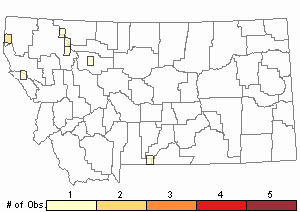
Recency
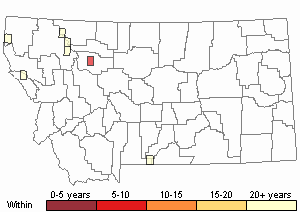
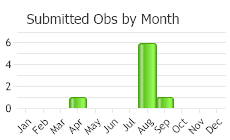
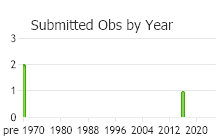
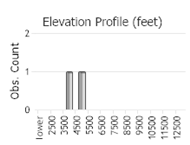 (Observations spanning multiple months or years are excluded from time charts)
(Observations spanning multiple months or years are excluded from time charts)
Habitat
Soil and soil over rock (Elliott 2016), calciphilic, sandy soils; low to high elevations (FNA 2007).
Reproductive Characteristics
Autoicous (FNA 2007). Straight or a little contorted, usually under 3 cm, red or red with brownish tones to ochre. Capsule inclined, exserted, brown, 1-1.5 mm, a little creased when dry (FNA 2007).
References
- Literature Cited AboveLegend:
 View Online Publication
View Online Publication Elliott, J.C. and A.K. Pipp. 2018. A Checklist of Montana Mosses (1880-2018). Updated 3 January, 2020. Montana Natural Heritage Program, Helena, Montana. 73 pp.
Elliott, J.C. and A.K. Pipp. 2018. A Checklist of Montana Mosses (1880-2018). Updated 3 January, 2020. Montana Natural Heritage Program, Helena, Montana. 73 pp. Flora of North America Editorial Committee, eds. 2007. Flora of North America North of Mexico. Volume 27. Bryophytes: Mosses, Part 1. Oxford University Press, Inc., NY. xxi + 713 pp.
Flora of North America Editorial Committee, eds. 2007. Flora of North America North of Mexico. Volume 27. Bryophytes: Mosses, Part 1. Oxford University Press, Inc., NY. xxi + 713 pp.
- Additional ReferencesLegend:
 View Online Publication
View Online Publication
Do you know of a citation we're missing? Elliot, J. C. 1993. Second checklist of Montana mosses. Unpublished report. U.S. Forest Service, Region 1. Missoula, MT. 45 pp.
Elliot, J. C. 1993. Second checklist of Montana mosses. Unpublished report. U.S. Forest Service, Region 1. Missoula, MT. 45 pp. Lawton, E. 1971. Keys for the Identification of the Mosses on the Pacific Northwest. Reprinted from 'Moss Flora of the Pacific Northwest'. Published as Supplement No. 2 of the Journal of the Hattori Botanical Laboratory. Nichinan, Miyazaki, Japan. 66 pp.
Lawton, E. 1971. Keys for the Identification of the Mosses on the Pacific Northwest. Reprinted from 'Moss Flora of the Pacific Northwest'. Published as Supplement No. 2 of the Journal of the Hattori Botanical Laboratory. Nichinan, Miyazaki, Japan. 66 pp. Lawton, E. 1971. Moss Flora of the Pacific Northwest. Hattori Botanical Laboratory. Japan: Yamabuki-cho, Shinjuku-ku, Tokyo. 362 pages plus appendices.
Lawton, E. 1971. Moss Flora of the Pacific Northwest. Hattori Botanical Laboratory. Japan: Yamabuki-cho, Shinjuku-ku, Tokyo. 362 pages plus appendices.
- Web Search Engines for Articles on "Incline Thread Moss"





